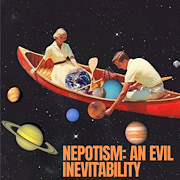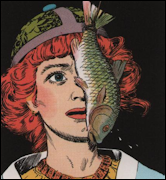|
In the seventeenth and eighteenth centuries, it was popularly believed that a young bride's first pregnancy was much shorter than subsequent ones. At the same time, 17th C French sex and medical manuals were amazingly frank and correct about many things. They not only knew where the clitoris was, but what it was for. They described it as a 'male member in miniature'. Stimulation was needed for proper 'fulfillment' of the woman, and an orgasm was necessary for conception to occur. In a world with a horrendous child mortality rate, one where your only hope for security in your old age was your family, contraception was not something to be desired.
|
|
|
|

|
| # ? May 13, 2024 22:42 |
|
There's honestly not much to elaborate on with Manchuria. In this case were talking about whats generally called Outer Manchuria, because Manchuria is kind of a loose concept. Basically as the Chinese puppet state fell into disarray and the power shifted from the powerless final emperors of China to the Warlords who lived on the frontiers. The populous parts of China were under a twofold economic attack. Foreign interests controlled markets and mandated policy. The Heaven and Earth Society, an old group of conspirators who had long devoted their lives to overthrowing the current Chinese dynasty suddenly found the current Chinese dynasty doing that without their help. They immediately turned their eyes away from deposing the Emperor and into organized crime and almost overnight in the pre-WWI era massive warring crime families sprung to life across south east China and began to heavily control the black markets. This meant that the value of work, property and money to the average Chinese citizen was suddenly in the shitter, and all of the big cities of China suddenly became awful shitpiles to live in, because if you wanted to get what you needed to live you sometimes had to convert between half a dozen currencies and deal with either corrupt local officials and corrupt local taxation, or the mob. But you know who were doing really good? The warlords out on the frontier! You see, China as a unified state was always tenuous, even after the major wars that unified most of the major states hundreds of years earlier. And when the power began to leave the throne, basically the entire Chinese frontier went with it. The foreigners could barely control the capital, there was no way they were going to travel hundreds of miles north into the Chinese plains or southern Russia to yell at a few hundred rogue soldiers. These places started doing quite well for themselves, there was a lot of resources in these areas and the vast trade monopolies and corruption had stymied the legitimate governments ability to take advantage of any of them. Manchuria was a totally unmined frontier just waiting to harvested but the people who should have been doing it weren't capable. This all got changed up when foreign interests bullied China into building a railway through Manchuria into Southern Russia. Now it was loving go time! The railroad opened up the path to carry resources out of the country into European markets, and the Warlords took notice. The population of Manchuria suddenly tripled in the following decade and a sort of Wild West of the East was born. You even had guys who had been legitimate Wild West dudes in America travelling over there to oversee railway construction and mining efforts, much like they had done with the trans continental railway in America. And eventually it became a point of contention to all the surrounding powers. Japan wanted it to cut off Russia from the sea, from China and from Korea. Russia wanted it to maintain access to the Sea of Japan, Korean ports and to China. And China wanted it because, dammit, it belonged to them, the Chinese government was just taking a break for a while, OK? So same basic conditions as the early west in America, multiple nations abutting an area of vast wealth and few people, all of whom wanted parts of it for resources and who's fate would ultimately be decided by the path of a single railway. The difference with Manchuria was you had actual warlords, and also shitloads of real rear end guns. It wasn't guys who had never held a pistol before buying a colt and wandering into the great unknown anymore. China had been in conflict for years, millions of dollars in arms were pouring in, basically every man under the age of 25 was being press ganged into some form of militia, self defense force, gang, warlord army or national army. The western powers put up an arms embargo, preventing the import of military arms into the country, the Spanish, Americans and Swiss built factories and began importing thousands of "target pistols" (Luger and Mauser knockoffs with detachable stocks), "sporting rifles" (Winchester lever guns in pistol or short calibers) and "hunting rifles" (now obsolete bolt action battle rifles that had been drilled for scope mounts, or ones that weren't in strict military calibers). It's often talked about in military history circles that in the post WWI climate, every military power on earth knew that what had just happened was going to happen again but worse. And so in the following decades there were several conflicts that would be deemed testing grounds for the modern arms and tactics that would be carried into the second World War. The most famous of these was the Spanish Civil War but Manchuria and the Chinese Warlord Era in general was a much more subversive theater. It should also be noted that Manchuria, for most of it's history, was very ethnically and culturally distinct from the rest of China. It was always a remote place, and in the 1800s was basically the Mos Eisley Cantina of countries. Large groups of bandits controlled most of the resources as the lovely sons of Chinese clans (because that's who go assigned to rule the rear end-end of nowhere) bitch slapped each other over who got to steal the most gold from the native populations. Eventually the traditional tribal structure of the natives fell apart and was basically completely gone by the middle of the 1800s, along with any semblance of law, order or organized rule. Even for late era imperial China it was out of control levels of corruption, and before the railroad there just wasn't any way to really capitalize on the natural resources. So it was small bands of people mining mediocre amounts of gold and then having it stolen or ripped off from them for minuscule amounts of money so that corrupt Chinese scions could play king.
|
|
|
|
Ok this is from a few posts back, but let it just be noted for the record that there were absolutely not preserved bodies with hair at Pompeii. There were human shaped cavities in ash that allowed highly detailed plaster casts to be made. To contribute a historical fun fact: Pompeii at the time of its burial had a roughly equal number of bakeries (i.e. the thing that provides your staple food to rich and poor alike) and houses of prostitution. They were next door to a busy port and known to be a resort town of sorts so there was apparently a substantial demand.
|
|
|
|
I think all of this is super fascinating, you wouldn't happen to have anything else you'd like to share on the subject would you? I don't have much to contribute, this is more of an aside: I had a relative (great-something grandfather) who fought in the Revolutionary War as infantry. He was a volunteer in the 8th Regiment out of New Hampshire, and they had a nickname: The Pious Eighth. The joke being that they were anything but pious. My mother, who did all the genealogical work (in the 90's and early 2000's, so no real internet) relayed a story to me in which they attempted to mount the division on horses. Unfortunately, most of the soldiers were poor Irishmen who'd never owned a horse in their life, and it was a complete disaster. (he survived the war, bought a farm in New England, and raised several surviving children with his wife btw)
|
|
|
porkswordonboard posted:I think all of this is super fascinating, you wouldn't happen to have anything else you'd like to share on the subject would you? If you're interested, Wikipedia has a fuckton of articles on the history of fashion. They go all the way back to Ancient Egypt and the caveman's loincloth, but Western fashion is divided into time periods. Like start here for 400-1100 and use the table of links at the bottom to continue on. What I've learned is that while popular culture tends to just use a generic appearance for everything medieval and Renaissance (and we really did have slow, subtle changes for centuries and similarities in male and female clothing), the 14th and 15th century is when the idea of "fashion" in general starts to come into play. European society started experimenting with different styles and decorations, and you could be recognized as wearing out-of-date clothing; a lot of fiction has used the "Your dress is sooo 1590s!" joke, but that's actually something that would have made sense! Most of the changes are still pretty subtle to the eye and you'd have to be told the differences to notice them. Like in certain decades you'd see ruffs or sleeves larger or smaller than normal; a common trend is that one particular bit of style starts increasing in prominence and elaborate presentation (whether it's the size of a man's collar or the decorative ribbons and puffs on his shoes) over the course of about a decade, at which point everyone suddenly grows tired of it and throws it out. As I said before, it wasn't really until around 1795 that you started seeing fashions for the wealthy and the poor merge. The Industrial Revolution started the process of making clothing cheaper; clothes used to be fantastically expensive even if they were plain, so most peasants would have few or no changes of clothes and they wouldn't even wash them regularly to avoid damaging the fibers or dyes through frequent cleaning, but improvements in material quality and the expansion of industrialized clothing manufacture started to make clothes cheaper. Even as recently as the 1950s your average person would still only have a few changes of clothes (think 3 skirts and 4 blouses to make combinations with, plus a jacket in the cold), but it was a huge improvement in letting people keep their fashions up to date. The French Revolution played a huge part, what with the desire to avoid looking like an aristocrat when aristocrats had a nasty habit of being murdered. Marie Antoinette caused a scandal in her 20s when she got tired of the court life and retreated to a sort of countryside villa with her friends, dressing in well-tailored versions of peasant outfits instead of the complex and uncomfortable royal clothing with panniers too big to fit through an average doorway. There was an outcry when she had a portrait painted in these clothes, as it was viewed as highly improper for her to be wearing something so simple. And there's the aforementioned abandoning of knee-high breeches for ankle-length trousers; the French rebels were referred to as sans-culottes, "without breeches". One other less well-known fashion choice was Artistic Dress and Aesthetic Dress. The period of 1850-1900 saw a revival of interest in the artwork of the Renaissance "old masters" like Michelangelo and Raphael. Painters dressed with models in faux-medieval and Renaissance clothing, which ended up becoming adopted as a new style of dress. It's most distinguished by people dressing in imitation medieval clothing in the 1860s and 1870s (much like how in the 1800s people were dressing like Ancient Greeks), but in general it encompasses all of the styles that weren't the contemporary silhouette: thin corseted waist, artificially widened hips or oversized butts, and lavish decoration. You also saw people with dressing gowns patterned like Japanese kimonos or Oscar Wilde's weird quasi-Renaissance "lecturing costume." The 19th century also saw the same subtle changes as you did in medieval and Early Modern times. Changes in women's clothing can only really be distinguished by things like how comically huge the sleeves and panniers/petticoats are, or if they're wearing a bustle (the "fake giant butt") instead of a conical petticoat. Men's clothing went through fewer, even more subtle changes like the cut of a jacket. The 1920s is when fashion really took off and you got the radical differences of every subsequent decade. chitoryu12 has a new favorite as of 22:55 on Nov 4, 2016 |
|
|
|
|
chitoryu12 posted:The 1920s is when fashion really took off and you got the radical differences of every subsequent decade. IDK, when historians look back at this period of time they're going to say things like "subtle changes like the length and cuff style of jeans"
|
|
|
Gravitas Shortfall posted:IDK, when historians look back at this period of time they're going to say things like "subtle changes like the length and cuff style of jeans" It really is the pace of modern technology that's allowed the 20th century's evolution to happen. Clothes are getting cheaper every year, to the point where any random bozo can buy a custom t-shirt with whatever graphics they want for a low price, or a guy running a small online business out of his home can commission and sell clothes with custom graphics. The ease with which fashion can be acquired breeds innovation, so it ends up changing as fast as tech does.
|
|
|
|
|
I had to go look up the painting of Marie Antoinette you mentioned. Scandalous.
|
|
|
|
Khazar-khum posted:In the seventeenth and eighteenth centuries, it was popularly believed that a young bride's first pregnancy was much shorter than subsequent ones. I dunno that it was popular knowledge that women had shorter pregnancies with their first born children, but there's no doubt that the first birth was usually 7-8 months after the marriage. I've heard of people making the "amusing observation" that first pregnancies are shorter, but not any actual text on it. I'd like a source to contemporary discussion on the matter if possible cause that'd be super interesting!
|
|
|
|
An example of things being out of style is The Meagre Company A lot of those dudes are wearing the circular collars that stand up a bit, while the really fashionable officers have collars that look more like a lace tablecloth. Fashion!
|
|
|
|
Red Bones posted:The Dutch approach to controlling the spice trade in the West Indies/southeast Asia was that they'd arrive at an island and force whoever the local ruler was to become a client state of the Dutch so they could secure favourable export rates and prevent them trading with other people. If they arrived at an island that didn't have a local ruler but ruled by committee instead, as in the case with the Banda Islands where nutmeg was grown, they decided a better approach would be to kill everyone on the island, import a bunch of slave labour and grow the nutmeg that way instead. The population of Bandanese on the islands went from around 14,000 to zero, and then to 500-odd when Dutch quickly returned some enslaved individuals to the island when they realised that they needed some people around to show them how to actually grow the nutmeg. Going back to Nutmeg and the Banda Islands reminds me of the pivotal role that Nutmeg and the island of Run played in world history. The Nutmeg tree is native to these islands and for a long time only grew there. Nutmeg and Mace had been traded to Europe in the medieval period by Arab traders and was very costly and very desired especially as it was believed to protect against diseases such as the plague. As Red Bones described the Dutch waged war to control the Banda islands and the lucrative Spice trade. However the English, led by Nathaniel Courthope, got to Run first and offered the inhabitants the protection of the English Crown from the Dutch in exchange for their nutmeg. The locals agreed and became the first English Overseas Colony. Nathaniel, along with 39 Englishmen and the local population held the island against the Dutch for 4 years. Eventually Nathaniel was ambushed and killed in 1620 while getting supplies and the island was abandoned by the English and locals to the Dutch. The English and the Dutch (and lots of other European nations) all continued to clash around the world as they attempted to establish colonies anywhere they could. A treaty in the 1650's was supposed to hand Run back to the English but the Dutch chased them off and destroyed all the nutmeg trees on the island instead. Eventually the Treaty of Breda in 1667 settled the matter of the island of Run. The Dutch would keep Run as they had occupied it for so long and in exchange the English could keep an island and a colony that they had captured and occupied from the Dutch. That island was Manhattan and the colony was New Amsterdam or New York as the English had renamed it. Yup, the Dutch traded New York for Run and nutmeg. To be fair they probably thought they got the better deal at the time. They had the monopoly on the lucrative trade in nutmeg and mace and held that until the Napoleonic wars when the English were able access the Banda islands and took nutmeg seeds and soil to establish plantations in English held territory in SE Asia.
|
|
|
|
chitoryu12 posted:It really is the pace of modern technology that's allowed the 20th century's evolution to happen. Clothes are getting cheaper every year, to the point where any random bozo can buy a custom t-shirt with whatever graphics they want for a low price, or a guy running a small online business out of his home can commission and sell clothes with custom graphics. The ease with which fashion can be acquired breeds innovation, so it ends up changing as fast as tech does. 1810s:  1830s:  1860s:  1880s:  I'm not saying these changes are MORE dramatic than 20th century ones, I am saying that they are not significantly subtle and although we currently live in an age of "fast fashion" we are not actually seeing significantly more or faster changes in overall appearance or silhouette, just greater diversity and a flourishing of fashion subcultures.
|
|
|
|
xthetenth posted:An example of things being out of style is The Meagre Company Nice over the shoulder pose, so they can show off their butts, racks, and face at the same time 
|
|
|
|
canyoneer posted:Nice over the shoulder pose, so they can show off their butts, racks, and face at the same time Men were sex objects back then. Landsknecht booty shorts were a thing.
|
|
|
|
xthetenth posted:Men were sex objects back then. Landsknecht booty shorts were a thing. See also codpieces  
|
|
|
|
xthetenth posted:Men were sex objects back then. Landsknecht booty shorts were a thing. yeah def
|
|
|
|
Terrorism in Europe actually declined in the 1990-2016 period compared to the 1970-1990 era. The country in which you would've been to most likely to die in an IED explosion? Italy. Radical groups from the left and the right did their fair bit of killing, but you could also die in mafia sponsored attacks, and don't forget about the separatist movements in Alto Adige and others. However, the most bizarre wave of terror were the Brabant massacres. A group of three bandits, known to the police only as Giant, Old Man and Killer killed over twenty people during the early eighties in Belgium. They mostly attacked supermarkets and restaurants, stole small amounts of cash, food and wine. But they killed everyone they could lay their hands on, sometimes torturing their victims to death. Or just shooting random shoppers in stores. Nobody knows what became of them, and the killings just stopped in 1985. Take the plunge! Okay! has a new favorite as of 15:10 on Nov 5, 2016 |
|
|
|
Take the plunge! Okay! posted:Terrorism in Europe actually declined in the 1990-2016 period compared to the 1970-1990 era. The country in which you would've been to most likely to die in an IED explosion? Italy. Radical groups from the left and the right did their fair bit of killing, but you could also die in mafia sponsored attacks, and don't forget about the separatist movements in Alto Adige and others. That's pretty interesting. Not Northern Ireland?
|
|
|
|
Wheat Loaf posted:That's pretty interesting. Not Northern Ireland? If you don't count servicemen, by far. Even if you do, I think it's a close call. The Italians had a thing for bombing moving trains and crowded train stations. edit: also, your IEDs tend to be more efficient if they come from secret NATO caches instead of actually being improvised. Take the plunge! Okay! has a new favorite as of 14:28 on Nov 5, 2016 |
|
|
|
Take the plunge! Okay! posted:edit: also, your IEDs tend to be more efficient if they come from secret NATO caches instead of actually being improvised. I don't think that's called and IED, I think that's called a "mine".
|
|
|
|
The "Years of Lead" from about 1968 to 1982 were a wild time in Italy, during which your most popular conspiracy theories like various secret services committing false flag terror attacks as well as a Masonic lodge literally forming a secret cabal within the Italian elite that conspired to overthrow the government, not to forget various left-wing and right-wing extremist groups running wild as well, often with clandestine support by the Soviets and the Americans too
|
|
|
|
Powaqoatse posted:See also codpieces Weren't codpieces also used as purses? I remember reading about that somewhere. Maybe pickpockets were less inclined to grab your money if it meant grabbing your junk too.
|
|
|
|
queserasera posted:Weren't codpieces also used as purses? I remember reading about that somewhere. Maybe pickpockets were less inclined to grab your money if it meant grabbing your junk too. Or maybe the purse-owners were counting on exactly that 
|
|
|
|
Rutibex posted:I don't think that's called and IED, I think that's called a "mine". No, the "improvised" in IED actually refers to the mechanism to detonate the device, not the charge IIRC. So if you rig up a mine to detonate off a cellphone or a booby trapped flashlight or something it's absolutely an IED.
|
|
|
|
VoteTedJameson posted:Ok this is from a few posts back, but let it just be noted for the record that there were absolutely not preserved bodies with hair at Pompeii. There were human shaped cavities in ash that allowed highly detailed plaster casts to be made. I've heard Pompeii be described as the Las Vegas of Ancient Rome. Is this true or just exaggeration?
|
|
|
|
canyoneer posted:Nice over the shoulder pose, so they can show off their butts, racks, and face at the same time http://www.rug.nl/research/portal/files/3346046/BremmerH5.pdf 
|
|
|
|
hes wearing heels lol
|
|
|
|
Agean90 posted:hes wearing heels lol
|
|
|
|
Agean90 posted:hes wearing heels lol Heels were made for men, to show off their calves.
|
|
|
|
Johnny Aztec posted:Heels were made for men, to show off their calves. which is the sexiest part of a man :16thand17thcenturysay: 
|
|
|
|
HEY GAL posted:it was to show off your body, but that pose those guys are doing is also a specific thing to this culture/time, which denotes manliness and martial power. read this article for more Such manly men. https://www.youtube.com/watch?v=xpPsbkHzrok
|
|
|
|
The heels and calves thing was related to horse riding. Horses were a status symbol and cavalry generally came from the nobility. If you could afford horses you were a Good and Proper man. This was also the colonial era where everybody was fighting everybody else pretty much all the time. Being a tough fighter was very socially important if you were a dude. Notice that the guy looking over his shoulder is turned to show off his boots. Specifically the back. He's wearing spurs. You had to earn the right to wear spurs and that only happened in battle. He's also holding riding gloves. He's saying "I am a total bad rear end that will gently caress up your kingdom and take your land" right there.
|
|
|
|
fencing and 17th c dancing is also fantastic for your calves
|
|
|
|
Take the plunge! Okay! posted:If you don't count servicemen, by far. Even if you do, I think it's a close call. The Italians had a thing for bombing moving trains and crowded train stations. Yeah, I was about to say that. It wasn't "terrorism" as much as a low-grade proxy war System Metternich posted:The "Years of Lead" from about 1968 to 1982 were a wild time in Italy, during which your most popular conspiracy theories like various secret services committing false flag terror attacks as well as a Masonic lodge literally forming a secret cabal within the Italian elite that conspired to overthrow the government, not to forget various left-wing and right-wing extremist groups running wild as well, often with clandestine support by the Soviets and the Americans too The conspiracies were all, 100% real. The theories only attempt to fill in the blanks CoolCab posted:No, the "improvised" in IED actually refers to the mechanism to detonate the device, not the charge IIRC. So if you rig up a mine to detonate off a cellphone or a booby trapped flashlight or something it's absolutely an IED. Most IEDs in the Middle East are artillery shells or landmines with an improvised detonator. Well, kind of: ISIS has industrialized the process of making IEDs so I don't know if anything about them can be said to be improvised
|
|
|
|
hackbunny posted:The conspiracies were all, 100% real. The theories only attempt to fill in the blanks Turns out I forgot a "became real" in my horrible run-off sentence The 70s were a wild time in Europe, basically. On a political, more visibile level you've got a time of détente, what with Brandt's Eastern Policy in Germany, Nixon's visits to Moscow and Beijing etc, while on the other hand you've got terrorist groups running rampant in Europe and the Middle East, the Vietnam War entering its last and nastiest phase what with Nixon bombing and invading Cambodia, various other proxy conflicts and wars springing up all over the globe etc. One of my secret wishes is for a GTA-style game set in 1974's West Berlin. Radicalised students, US and Soviet spies, creepy Stasi agents, literal Nazis prominently running around, the first big wave of immigration into Western Germany and all of that set to the awesome music of the time in a city split in two by a yooge wall that also functioned as a literal frontline in the Cold War. It would be great
|
|
|
|
System Metternich posted:
Fits into the Mafia series or Assassin's Creed series well
|
|
|
|
It's basically The Saboteur.
|
|
|
|
An Assassin's Creed game set in a divided Germany during the Cold War would be amazing.
|
|
|
|
Assassins Creed: Seoul. You play as a plucky North Korean agent who has snuck across the border (on a special mission from Eternal President Kim himself). Do you stay loyal to Juche and carry out your mission, or do you give into your newly discovered love of K-pop and attempt to stay?
|
|
|
|

|
| # ? May 13, 2024 22:42 |
|
Rutibex posted:Assassins Creed: Seoul. Kpop is templar propoganda.
|
|
|











































